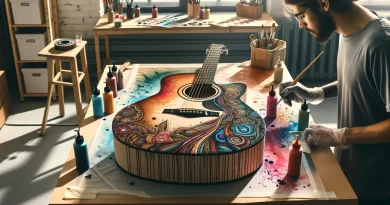A Complete Guide for Beginners
Connecting your guitar to PC isn’t just about making noise—it’s about making magic! Are you ready to explore the limitless possibilities of your guitar through the power of digital technology? From transforming your practice sessions with a galaxy of sounds to broadcasting live concerts from your couch, the digital realm opens up a whole new world for guitarists. Whether you’re recording your first track or looking to enhance your learning, let’s dive into how you can harness the full potential of your guitar with just a few clicks.
Why Connect Your Guitar to PC?
Connecting your guitar to PC opens up a myriad of possibilities for both novice and experienced guitarists. Here are some reasons:
Level-Up Your Practice Sessions
Have you ever wished for a room filled with amps and effects pedals? Well, by simply connecting your guitar to a PC, that wish comes true. With a plethora of amp simulations and effects available, it’s like having your very own unlimited playground of sound. Imagine, with a few clicks, you’re basking in the warm tones of a vintage Marshall amp or adding a dash of chorus for that nostalgic 80s vibe — all from the comfort of your own home.
Moreover, you can record your practice sessions effortlessly. This allows you to revisit your solos and riffs, identify areas for improvement, and track your progress over time. It’s like having a personal recording studio at your disposal, minus the hefty price tag!
DIY Home Recording? Yes, Please!
Ready to create some tracks and share your music with the world? Hooking up your guitar to a PC is your first step to becoming a DIY recording artist. With a decent interface and a Digital Audio Workstation (DAW), like GarageBand, Pro Tools, or Ableton Live, you can capture high-quality recordings without the need for a professional studio.
These DAWs offer powerful editing tools that let you layer tracks, adjust volumes, and add effects until your song sounds just right. Plus, you can do all this while in your pajamas — how’s that for convenience?
Your Living Room, Your Concert Hall
In this age of virtual concerts and Instagram live sessions, connecting your guitar to a PC allows you to broadcast your music with studio-quality audio. You can engage with fans around the globe, right from your living room. Plus, it’s perfect for conducting online music lessons and workshops, helping you share your skills with budding guitarists everywhere. Who knows? Your next big gig might just be a mouse click away!
Master Your Craft with Interactive Learning
Gone are the days when learning guitar meant squinting at cryptic tablature books or endlessly rewinding cassette tapes. With your guitar connected to a PC, you gain access to a wealth of interactive lessons, tutorials, and software.
Platforms like Yousician or Rocksmith can provide real-time feedback on your playing, helping you improve faster and more effectively. It’s like having a personal guitar tutor on call 24/7, minus the awkward small talk!
Unleash Your Creativity with Digital Effects
Lastly, let’s talk about the fun part: experimenting with a vast library of digital effects. Have you ever wondered how your guitar would sound if it passed through a wah-wah pedal, followed by a flanger, a phaser, and a bit-crusher? Now, you can discover exactly that!
From classic effects to outlandish tones, the possibilities are endless. Plus, you can save your custom sound profiles for future use, allowing you to craft a distinctive musical identity. It’s like being a kid in a candy store, except with no impending sugar crash.
Syncing Your Electric Guitar to PC
Audio Interface: The Heart of Your Digital Setup
Now, you might be scratching your head, wondering, “Alon, why on earth do I need this little box?” Well, my friend, the audio interface is your golden ticket to the world of digital sound. It’s like a translator, converting the raw, analog signal from your guitar into a digital language that your PC can understand. Plus, it’s the guardian of your sound quality, ensuring that there are no annoying delays or latency issues while recording or performing live.
Here’s where we roll up our sleeves and get our hands dirty. Follow these steps to connect your guitar to your PC using an audio interface:
- Pick an audio interface that is compatible with your PC’s ports (USB or Thunderbolt are the usual suspects).
- Connect the interface to your computer using the provided cable.
- Using a standard ¼” jack cable, connect your guitar to the interface.
- Tweak your computer’s audio settings to align with the interface.
- Lastly, install any drivers or software that come with the interface to ensure a seamless operation.
So, which audio interface should you go for? On top of my list are the Focusrite Scarlett series and the Presonus Audiobox USB 96. Both are reputable for their top-notch quality, user-friendliness, and won’t make your wallet cry.
The Magic of Multi-Effect Pedals
You might be surprised to hear this, but some multi-effect pedals are like undercover agents, doubling as a USB interface. They allow you to record directly to your PC while using your pedal effects during the recording process. It’s like hitting two birds with one stone, simplifying your setup and delivering the unique tones you adore.
Looking for a multi-effect pedal that carries a built-in USB interface? The Line 6 POD HD500X and the Boss GT-100 are two of my favorites. They’re both versatile, user-friendly, and can connect directly to your PC.
The Unsung Hero: Your Guitar Amp
It turns out, modern guitar amps aren’t just for live gigs. Some have USB outputs, allowing you to record directly to your PC using your amp’s built-in effects and modeling. If you’re in love with your amp’s sound and want to immortalize it in your recordings, this method is a winner.
If you’re on the hunt for a new amp with USB connectivity, the Fender Mustang GT series is a worthy contender. For those who prefer a more petite amp, the Yamaha THR10II offers studio-quality sound and USB connectivity for recording, all in a compact package.
Connecting Acoustic Guitars to PC
Ever wished you could capture the sweet, soulful sounds of your acoustic guitar directly onto your computer? Well, you’re in for a treat! This guide is going to take you on a musical journey, showing you how to connect your acoustic guitar to PC. Whether you’re a beginner or a seasoned strummer, there’s something for everyone here.
For Those Acoustic-Electric Guitarists Out There
If your acoustic guitar is the cool cousin with built-in electronic pickup, you’re in luck! Connecting it to a PC is as simple as tuning a G-string. Just grab a standard ¼” jack cable, an audio interface, and your loyal six-string companion. Remember, your guitar’s volume and tone controls are your secret weapon, tweaking them can help you achieve that perfect sound.
What About Acoustic Guitars Without Built-In Electronics?
Don’t sweat it, my pure acoustic buddies! You might need a touch more gear, but your guitar can still croon sweetly to your PC.
The easiest way to record your acoustic guitar’s sound is by using a microphone. Position it in front of your guitar and experiment until you find the ‘Goldilocks’ spot – not too close, not too far, just right. Connect the microphone to the audio interface, then to your PC, and voila! You’re ready to serenade the digital world.
Looking for a microphone that can do justice to the unique sound of your acoustic guitar? Here are our top picks, each with its own strengths:
- Aston Origin: Perfect for capturing classic sound with pinpoint accuracy.
- Shure SM81: Proven industry favorite, delivering excellent value and acoustic nuance.
- Audio-Technica AT2035: Pocket-friendly, but still offers sturdy build quality and superb sound.
- Neumann KM 184: A premium choice known for capturing the subtleties of acoustic finger work.
Got a Pickup? Here’s How to Use It
If you’re planning to use a pickup, know that you have options. You can permanently install it or choose a removable one. Once installed, just connect the jack cable from the pickup to the audio interface. Easy peasy lemon squeezy!
Thinking of investing in a pickup system? Here’s what we recommend:
- LR Baggs Anthem: This system marries a piezo pickup with a microphone for full dynamic range capture.
- Fishman PowerTap Infinity: This blends a traditional pickup with a body sensor to capture the true acoustic sound.
The USB Microphone Route
If simplicity is your jam, a USB microphone could be your best buddy. It’s a plug-and-play solution that bypasses the need for an audio interface, making it perfect for quick and fuss-free recording setups.
Here are our top picks for USB microphones perfect for acoustic guitar recording:
Software Considerations
Once your guitar’s got its digital voice, you’ll need a Digital Audio Workstation (DAW) to record and finesse your guitar’s sound. Choose software that offers plugins or effects specific to acoustic guitars for a sound that hits all the right notes.
Whether you’re a Mac or Windows user, we’ve got you covered. Here are our top DAW recommendations:
- GarageBand: User-friendly and ideal for Mac users. A hit with beginners and advanced users alike.
- Ableton Live: Known for its intuitive interface and powerful features. Compatible with both Windows and Mac
Frequently Asked Questions
How do I connect my electric guitar to a PC?
You can connect your electric guitar to a PC using an audio interface, a USB microphone, a multi-effects pedal with a USB output, or a guitar amp with a USB connection.
What equipment do I need to connect my guitar to a PC?
The essential equipment includes an audio interface or a USB adapter, a standard ¼” jack instrument cable, and possibly additional software like a Digital Audio Workstation (DAW).
Can I connect my acoustic guitar to a PC if it doesn’t have built-in electronics?
Yes, you can use a microphone to capture the sound of your acoustic guitar or install a pickup to connect it to an audio interface, which then connects to your PC.
Do I need special software to record my guitar on my PC?
While not strictly necessary, using a DAW can greatly enhance your recording experience. Popular DAWs include GarageBand for Mac users and Ableton Live for both Windows and Mac users.
Can I use my PC as a guitar amplifier?
Yes, once your guitar is connected to your PC, you can use software with amp simulation to emulate the sound of various guitar amplifiers.
Conclusion
Connecting your guitar to PC is not just about stepping into the realm of digital music; it’s about unleashing your creative potential in ways that were once unimaginable. Whether you’re capturing the soulful sounds of an acoustic, riffing on an electric, or exploring the vast universe of sounds and effects, the possibilities are virtually endless. By integrating your guitar with your PC, you can elevate your music, share it with the world, and even transform your home into a dynamic studio and stage. So plug in, play on, and let the digital revolution enhance every strum and solo!
Originally posted by Alon Cooper at https://guitarsongsmasters.com/guitar-to-pc-complete-guide/



